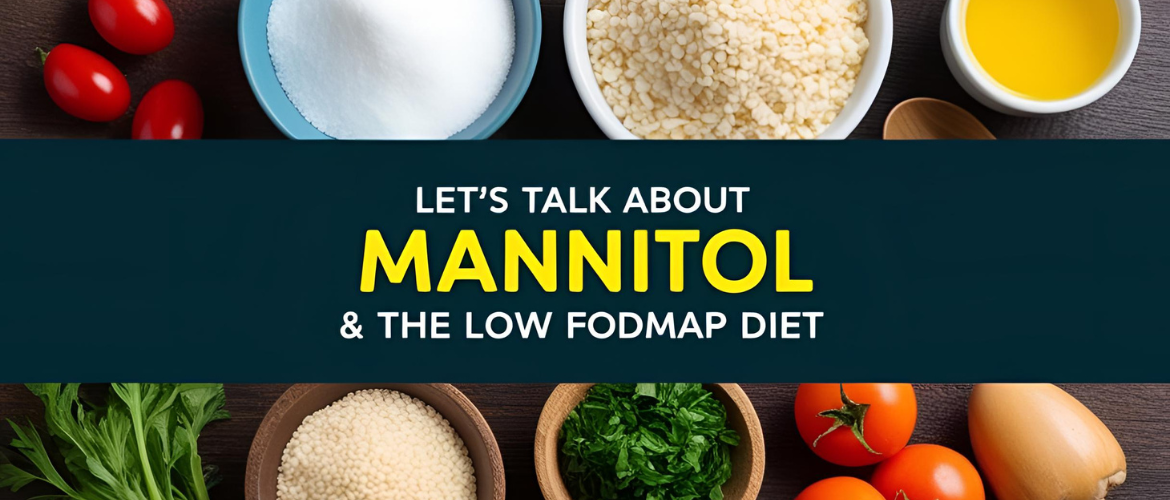No products in the cart.
Let’s Talk About Mannitol & the Low FODMAP Diet

Introduction: Facing Digestive Challenges Head-On
For many Americans dealing with irritable bowel syndrome (IBS), small intestinal bacterial overgrowth (SIBO), or digestive discomfort, navigating the maze of dietary triggers can feel overwhelming. If you’ve struggled with gas, bloating, and abdominal pain, you might have already heard about the Low FODMAP Diet—a tailored eating plan designed to reduce symptoms by minimizing specific short-chain carbohydrates. One such carbohydrate is mannitol, a type of sugar alcohol that can be both a hidden culprit and a point of learning on your journey to better gut health. Today, let’s delve into what mannitol is, how it impacts your digestive system, and why managing its intake is essential for a successful Low FODMAP Diet.
What Is Mannitol?
Mannitol is a naturally occurring sugar alcohol found in various fruits and vegetables, including mushrooms, cauliflower, and certain types of apples. It’s also used as a low-calorie sweetener in many processed food products. Despite its appealing sweetness and lower calorie content, mannitol is classified as a polyol—one of the five FODMAP groups that can trigger symptoms in sensitive individuals.
For many people, even small amounts of mannitol can set off a chain reaction in the gut. Its nature as a poorly absorbed carbohydrate means that it can ferment in the colon, leading to gas production, bloating, and discomfort. If you’re on the lookout for digestive relief, reducing or eliminating mannitol might be an important step.
The Low FODMAP Diet: Your Roadmap to Relief
The Low FODMAP Diet has emerged as a game-changer for those managing IBS and other digestive disorders. FODMAP stands for Fermentable Oligo-, Di-, Mono-saccharides And Polyols—a group of short-chain carbohydrates that are difficult for many people to digest. By following a Low FODMAP Diet, you can minimize exposure to these problematic sugars and, in turn, reduce symptoms like abdominal pain, gas, and bloating.
A typical Low FODMAP Diet involves three phases:
- Elimination: Removing high FODMAP foods (including those high in mannitol) for a period of 4–8 weeks.
- Reintroduction: Gradually reintroducing certain foods to identify which ones trigger symptoms.
- Maintenance: Tailoring your diet based on personal tolerance levels.
Understanding and managing your mannitol intake is crucial during these phases, as even common ingredients in processed foods might contain enough mannitol to cause discomfort.
Mannitol’s Impact on the Digestive System
For many sensitive individuals, the consumption of mannitol can lead to a range of gastrointestinal symptoms. Here’s why:
- Osmotic Activity: Mannitol draws water into the intestines, which can accelerate bowel movements and cause diarrhea.
- Fermentation in the Colon: Since mannitol is not fully absorbed in the small intestine, it reaches the colon where gut bacteria ferment it, producing gas. This fermentation process can result in bloating, cramping, and pain.
- Triggering IBS Symptoms: For those with IBS or similar conditions, mannitol can exacerbate existing digestive issues, making it harder to manage daily discomfort.
Being aware of these effects can help you better tailor your diet to avoid or limit high-mannitol foods.
How to Manage Mannitol Intake on a Low FODMAP Diet
If you’re aiming to reduce digestive distress, managing your mannitol intake might be more straightforward than you think. Here are some practical tips:
1. Read Labels Carefully
Processed and packaged foods can be sneaky sources of mannitol. Always check ingredient lists for terms like “mannitol,” “sugar alcohol,” or “polyol” to avoid inadvertent consumption.
2. Familiarize Yourself with High-Mannitol Foods
Educate yourself on common foods that are naturally high in mannitol. Items such as certain mushrooms, cauliflower, and some fruits may need to be limited or substituted with lower FODMAP alternatives.
3. Experiment with Alternatives
For those with a sweet tooth, consider low FODMAP-friendly sweeteners such as stevia or small amounts of maple syrup in place of mannitol-based products.
4. Track Your Symptoms
Keep a food diary to monitor how your body responds to different foods. Not everyone is affected by mannitol in the same way; tracking your symptoms can guide you in making personalized dietary choices.
5. Consult a Dietitian
Working with a healthcare professional who specializes in the Low FODMAP Diet can make a huge difference. They can offer personalized advice, help create a balanced meal plan, and ensure you maintain proper nutrition while managing your symptoms.
Real-Life Success Stories
Many individuals have found relief by tweaking their diets to minimize high FODMAP ingredients like mannitol. Take Mary from Texas, for example. Mary struggled with bloating and erratic digestion for years until she began following the Low FODMAP Diet. By carefully eliminating high-mannitol foods and reintroducing them slowly, she identified her threshold and learned to balance her diet. Today, Mary’s digestive issues have significantly improved, and she enjoys a broader variety of foods without the associated discomfort.
Conclusion: Taking Control of Your Digestive Health
Digestive health isn’t just about managing symptoms—it’s about reclaiming your quality of life. For many individuals, refining your diet with the Low FODMAP approach is a powerful way to ease discomfort and restore balance. By understanding the role of mannitol and making informed adjustments, you can take meaningful steps towards lasting relief.
So, if you’re tired of battling unpredictable digestive issues and want to enjoy life without the constant worry of IBS or bloating, consider focusing on your dietary intake of substances like mannitol. Embrace a mindful approach to eating, and discover the benefits of a tailored, Low FODMAP Diet.
Ready to transform your gut health? Start by exploring the foods you eat and making small, impactful changes—because a happy, healthy gut is the cornerstone of a vibrant life.
Start your wellness journey today — Visit Unike Nutra Now
Follow us
Facebook – https://www.facebook.com/profile.php?id=61567462823245
Instagram – https://www.instagram.com/unikenutra/
Twitter – https://x.com/Unikenutra
LinkedIn: https://www.linkedin.com/company/unike-nutra/
Amazon: https://www.amazon.com/stores/UnikeNutra/

